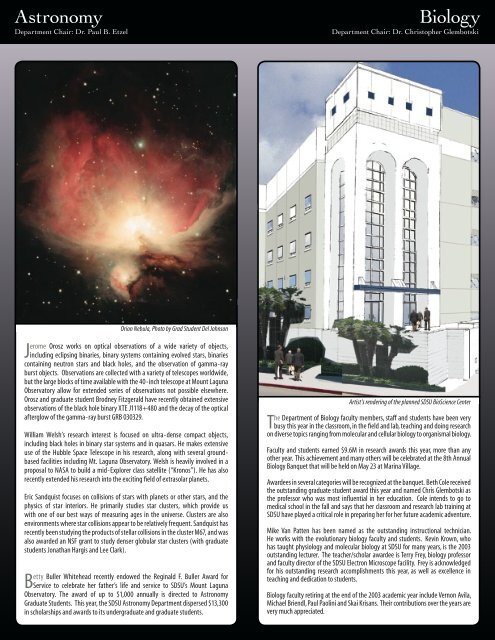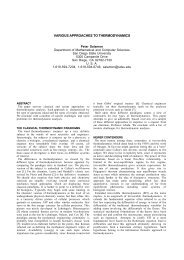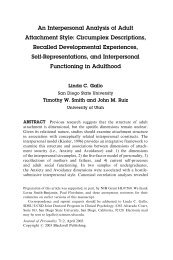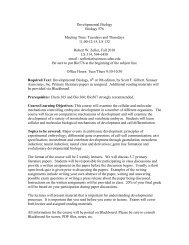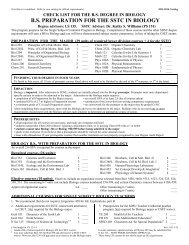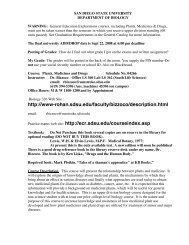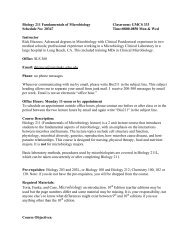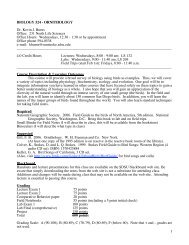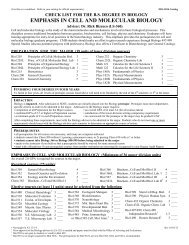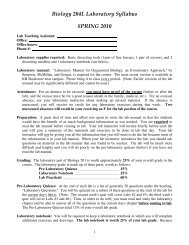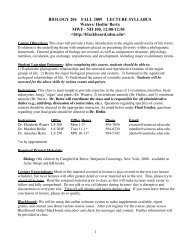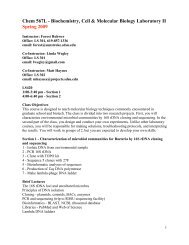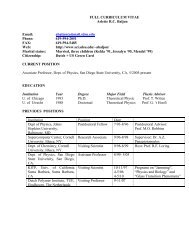sciences review web 2003 - The College of Sciences - SDSU
sciences review web 2003 - The College of Sciences - SDSU
sciences review web 2003 - The College of Sciences - SDSU
You also want an ePaper? Increase the reach of your titles
YUMPU automatically turns print PDFs into web optimized ePapers that Google loves.
Astronomy<br />
Department Chair: Dr. Paul B. Etzel<br />
Biology<br />
Department Chair: Dr. Christopher Glembotski<br />
Orion Nebula, Photo by Grad Student Del Johnson<br />
Jerome Orosz works on optical observations <strong>of</strong> a wide variety <strong>of</strong> objects,<br />
including eclipsing binaries, binary systems containing evolved stars, binaries<br />
containing neutron stars and black holes, and the observation <strong>of</strong> gamma-ray<br />
burst objects. Observations are collected with a variety <strong>of</strong> telescopes worldwide,<br />
but the large blocks <strong>of</strong> time available with the 40-inch telescope at Mount Laguna<br />
Observatory allow for extended series <strong>of</strong> observations not possible elsewhere.<br />
Orosz and graduate student Brodney Fitzgerald have recently obtained extensive<br />
observations <strong>of</strong> the black hole binary XTE J1118+480 and the decay <strong>of</strong> the optical<br />
afterglow <strong>of</strong> the gamma-ray burst GRB 030329.<br />
William Welsh’s research interest is focused on ultra-dense compact objects,<br />
including black holes in binary star systems and in quasars. He makes extensive<br />
use <strong>of</strong> the Hubble Space Telescope in his research, along with several groundbased<br />
facilities including Mt. Laguna Observatory. Welsh is heavily involved in a<br />
proposal to NASA to build a mid-Explorer class satellite (“Kronos”). He has also<br />
recently extended his research into the exciting field <strong>of</strong> extrasolar planets.<br />
Eric Sandquist focuses on collisions <strong>of</strong> stars with planets or other stars, and the<br />
physics <strong>of</strong> star interiors. He primarily studies star clusters, which provide us<br />
with one <strong>of</strong> our best ways <strong>of</strong> measuring ages in the universe. Clusters are also<br />
environments where star collisions appear to be relatively frequent. Sandquist has<br />
recently been studying the products <strong>of</strong> stellar collisions in the cluster M67, and was<br />
also awarded an NSF grant to study denser globular star clusters (with graduate<br />
students Jonathan Hargis and Lee Clark).<br />
Betty Buller Whitehead recently endowed the Reginald F. Buller Award for<br />
Service to celebrate her father’s life and service to <strong>SDSU</strong>’s Mount Laguna<br />
Observatory. <strong>The</strong> award <strong>of</strong> up to $1,000 annually is directed to Astronomy<br />
Graduate Students. This year, the <strong>SDSU</strong> Astronomy Department dispersed $13,300<br />
in scholarships and awards to its undergraduate and graduate students.<br />
Artist’s rendering <strong>of</strong> the planned <strong>SDSU</strong> BioScience Center<br />
<strong>The</strong> Department <strong>of</strong> Biology faculty members, staff and students have been very<br />
busy this year in the classroom, in the field and lab, teaching and doing research<br />
on diverse topics ranging from molecular and cellular biology to organismal biology.<br />
Faculty and students earned $9.6M in research awards this year, more than any<br />
other year. This achievement and many others will be celebrated at the 8th Annual<br />
Biology Banquet that will be held on May 23 at Marina Village.<br />
Awardees in several categories will be recognized at the banquet. Beth Cole received<br />
the outstanding graduate student award this year and named Chris Glembotski as<br />
the pr<strong>of</strong>essor who was most influential in her education. Cole intends to go to<br />
medical school in the fall and says that her classroom and research lab training at<br />
<strong>SDSU</strong> have played a critical role in preparing her for her future academic adventure.<br />
Mike Van Patten has been named as the outstanding instructional technician.<br />
He works with the evolutionary biology faculty and students. Kevin Krown, who<br />
has taught physiology and molecular biology at <strong>SDSU</strong> for many years, is the <strong>2003</strong><br />
outstanding lecturer. <strong>The</strong> teacher/scholar awardee is Terry Frey, biology pr<strong>of</strong>essor<br />
and faculty director <strong>of</strong> the <strong>SDSU</strong> Electron Microscope facility. Frey is acknowledged<br />
for his outstanding research accomplishments this year, as well as excellence in<br />
teaching and dedication to students.<br />
Biology faculty retiring at the end <strong>of</strong> the <strong>2003</strong> academic year include Vernon Avila,<br />
Michael Briendl, Paul Paolini and Skai Krisans. <strong>The</strong>ir contributions over the years are<br />
very much appreciated.


